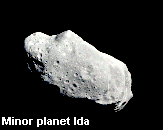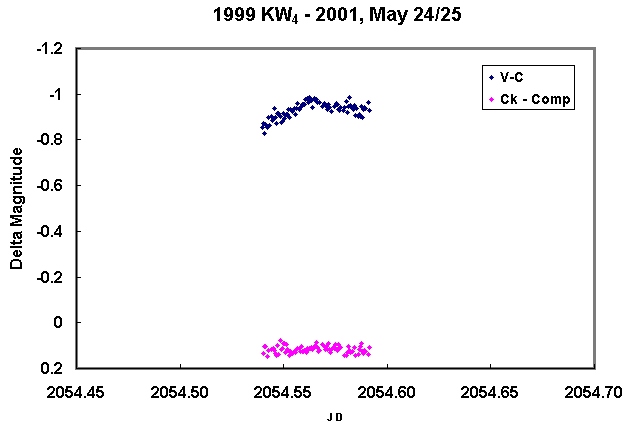 CBA
Belgium Observatory
CBA
Belgium ObservatoryObservations of Near Earth Object 1999 KW4
 CBA
Belgium Observatory
CBA
Belgium Observatory
Observations of Near Earth Object 1999 KW4
|
Minor planet 1999 KW4 was discovered in 1999 using the
LINEAR 1-meter telescope in New Mexico. It had an extreme close flyby in
May 2001, when it came within 4.8 million kilometers of Earth on May 25th.
It won't come this close again until 2019. The minor planet belongs to the
special class of Aten asteroids, which circle the Sun in less than a year
and range only briefly outside the Earth's orbit. Its orbit is shown in
the diagram below in brown color (the red circle represents the Sun.
Visible also are the orbits of Mercurius, Venus, Earth and Mars). |
 |
 |
We made our first observations of 1999 KW4 on 2001, May 24.08 UT, when this Near-Earth Object (NEO) was visible very low in the morning sky (about 10 degrees altitude), just before dawn. We collected 31 CCD images of 30 seconds each, showing the extreme speed of the minor planet. The session clearly was too short to perform any decent photometry. The next night was clear again, and allowed a somewhat longer session, that revealed a first fraction of the light curve of 1999 KW4. The nights of May 25/26, May 27/28 and May 29/30 all were clear again. We collected several hours of high quality images and were capable of building very spectacular light curves, showing the complex modulations in 1999 KW4's light curve. The table below presents an overview of our photometric observations at CBA Belgium Observatory. |
Log of observations :
| Date (UT) | Duration (h) |
Nbr frames |
 |
|
| 2001 May 24.081 - 24.096 | 0.36 | 31 | ||
| 2001 May 25.040 - 25.097 | 1.37 | 88 | ||
| 2001 May 25.909 - 26.096 | 4.49 | 284 | ||
| 2001 May 27.942 - 28.097 | 3.72 | 235 | ||
| 2001 May 29.895 - 30.099 | 4.90 | 308 | ||
|
Total |
14.84 | 946 |
|
In June 2000, Petr Pravec and Lenka Sarounova from Ondrejov
Observatory (Czech Republic) detected non periodic brightness fluctuations of
0.1 to 0.2 mag in the light curve of 1999 KW4. They suspected that maybe a
secondary component was involved, which would classify 1999 KW4 as one of the
few binary Near-Earth Objects. Confirmation for their assumption came on May
23rd, 2001, when astronomers working with radar images at Goldstone clearly
revealed the binary nature of the object (IAUC 7632). However, none of the
observations allowed to determine precise parameters of 1999 KW4's binary
system. Below is a selection of the light curves we obtained. Needless
to say that the light curve behavior is much too complex to be attributed to a
single component system. Its complexity, however, makes it extremely difficult
to derive the binary parameters of 1999 KW4. We hope that a combination of our
set of observations with others, obtained at different longitudes, will allow to
solve that puzzle ! |
 |
 |
 |
 |
|
Want
to learn more about NEO's ? Want
to join a list for comet and asteroid researchers worldwide ? Interested
in serious photometric observations of minor planets ? |
|
(c) Copyright Tonny Vanmunster, 2001 |